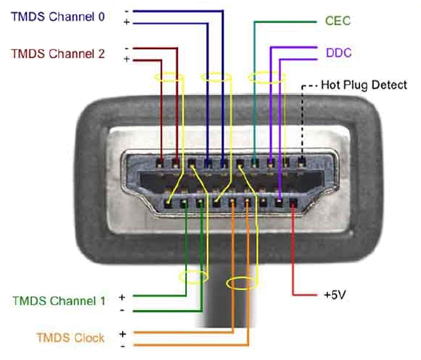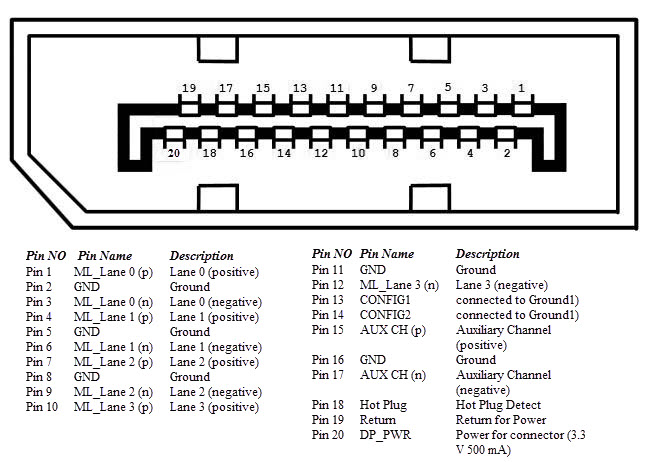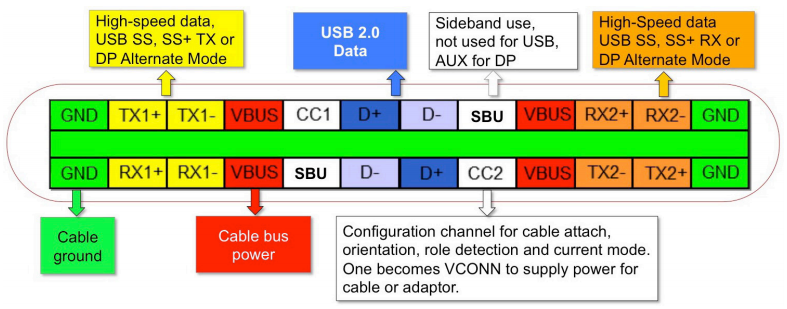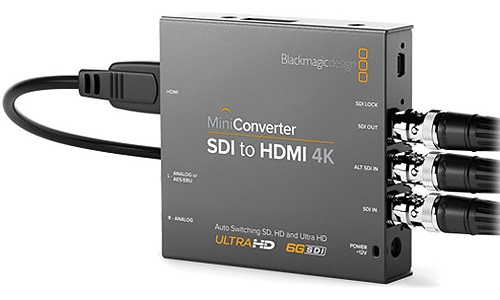Video connectors and cables
There have been a variety of video cable and connector types over the years, each providing its own set of capabilities and challenges. From composite, s-video, and component, to RGBHV and VGA, there have been no shortage of analog video protocols and connector types to choose from. Then, the advancement of digital video technologies introduced new connectors: DVI (which also has an analog video option), HDMI, and DisplayPort.
Some of these are compatible with each other, some can be easily adapted to, while others required active convertors, scalers, and adapters, sometimes adding complexity to an otherwise simple video transport system.
As technology has advanced, along with the need for and availably of higher resolution digital content, the legacy analog video connections and cabling have largely faded from use, being replaced by high bandwidth digital connections. These digital connections are not just passing video, but multi-channel audio, source and sink information, copyright protection, Ethernet, USB, and other data communication protocols. As the dust settles, two cable types and protocols have emerged as the front runners for passing high bandwidth digital content: HDMI and DisplayPort.
HDMI
The HDMI cable is comprised of 4 shielded twisted pairs, plus 7 separate conductors, carrying three separate communications channels: TMDS (Transition-Minimized Differential Signaling), DDC (Display Data Channel), and CEC (Consumer Electronics Control). It is transmitted over a 19-pin connector.
There are currently 4 types of HDMI cables available: Standard Speed, Standard Speed w/Ethernet, High Speed, and High Speed w/Ethernet. Standard Speed cables are specified for resolutions up to only 1080i and should be avoided, as the price difference between High Speed is minimal, and 4K content and displays are becoming more prevalent.
The "Ethernet" portion was introduced in HDMI v1.4 and provided for the optional addition of an HDMI Ethernet channel, known as HEC. A High Speed HDMI Cable w/Ethernet allows for two devices connected with an Ethernet enabled HDMI cable, to share a single wired Ethernet connection. The adoption of this functionality has not really taken off, in part, due to the current 10/100 max speed and absence of HEC enabled devices. For the purposes of this article, when referring to an HDMI cable, we are indicating a High Speed HDMI Cable.
Pinout

Pins 1-12 carry the TMDS communication, which includes video, audio, and auxiliary data information. These 12 pins form four separate channels for video data and clocking information, organized into three categories:
- Video Data Period - the active pixels of an active video line are transmitted
- Data Island Period - audio and auxiliary data is transmitted (occurs during horizontal and vertical blanking)
- Control Period - occurs immediately preceding each Video Data Period or Data Island Period and contains a Preamble indicating whether the next packets will be a Video Data or Data Island Period type
TMDS data is the primary factor in a cable's bandwidth specification. With the introduction of High Speed HDMI in the 1.3 Specification, we saw each TMDS channel support transmissions up to 3.4Gbps (10.2Gbps total). This is an increase from 7.5Mbps per channel found in Standard Speed HDMI. TesiraLUX utilizes the HDMI 2.0a Specification, which has a total bandwidth of 18Gbps (6Gbps on each TMDS channel), supporting resolutions up to 4K@60Hz, 4:4:4.
Pins 15-17 carry the DDC information. This communications channel carries two kinds of data: HDCP and EDID. HDCP is currently not supported in TesiraLUX, but will be implemented in a future release.
Pin 13 carries CEC communications. CEC makes use of this bi-directional connection to allow control of up to 15 devices. An example of this might be, pressing the power button on your flat screen remote, will also power on an HDMI connected blu-ray player and surround sound receiver. While a great idea in theory, some vendors have implemented this differently, causing incompatibility between devices. Currently, TesiraLUX will not transport CEC information as part of the AVB stream.
Pin 18 is utilized to provide +5V, provided by the source device. The HDMI specification requires a minimum of 55mA on this line for the purpose of reading the EDID of the display device. Some manufacturers will provide additional power to this pin, with the intention of powering active cables, or external signal boosters and inline EQ devices. With the potential variances in this power rating across devices, active extension cables, adapters, or similar inline powered devices may effect the IDH-1's ability to properly negotiate EDID and successfully receive the video signal. If needed, it is recommended to only use active extenders with external power supplies. The TesiraLUX OH-1 decoder provides the maximum power output allowed by the HDMI specification.
Voltage: 5.25V +/-1%
Current: 500mA Max
Biamp designed the TesiraLUX OH-1 power output to accommodate HDMI 2.0 cables. Even with power at the high end of the specification, poor quality HDMI cables may impair video transmission. HDMI Premium Certified cables are always recommended as the cables are tested for full 4K60 4:4:4 throughput operation. Active extended cables, HDMI to DisplayPort adapter and other inline powered devices may impair the ability of the OH-1 decoder to communicate and transmit video on the HDMI cable. We recommend using devices that receive external power via USB or DC input and that they are tested prior to installation.
Pin 19 is for a hot-plug detect, which will assist with reinitializing DDC, if needed, when reconnecting cables.
While there are technically 5 types of HDMI connectors, 3 will be found most commonly associated with audio/visual hardware and cabling:
Type A
Type A connectors are the most common; found on flat screen displays, blu-ray players, video switchers, and on the TesiraLUX IDH-1 and OH-1. This could be considered the "standard" HDMI connector and is representative of the pin-out diagram above.
Type C
Type C, or mini HDMI, is smaller than the type A connector, and was introduced as part of the HDMI 1.3 Specification. It's intended for portable devices such as cameras, tablets, and laptops with minimal port space. It also contains 19 pins, albeit, with a slightly different configuration.
Type D
Type D, or micro HDMI, as its name would suggest, is the smallest of the 3, intended for smaller tablets, cell phones, and similar sized mobile devices. Micro HDMI was introduced as part of the HDMI 1.4 Specification and has a 19-pin configuration that differs from both type A and C connectors.

All 3 connector types are compatible with one another, using either adapter cables or dongles. Maximum cable length is not indicated in the HDMI Specification, but would be somewhat resolution-dependent. There are many cables out there claiming to support 4K@60Hz at lengths up to 50 feet, but at this time the Premium High Speed HDMI Certification Program has only certified a max length of 25 feet.
Premium High Speed HDMI Cable
In the fall of 2015, HDMI Licensing Administrator, Inc (formally HDMI Licensing, LLC) launched the Premium HDMI Cable Certification Program. The program was designed to give consumers an assurance that the High Speed HDMI cable they are purchasing will support the 4K/Ultra HD features of the most recent HDMI Specification.
 Manufacturers participating in this program are required to submit their High Speed HDMI cables for testing at an HDMI Authorized Testing Center. Here, the cables undergo an expanded set of tests to certify that they can reliably support the full 18Gbps bandwidth of the HDMI 2.0 Specification. It's this expanded bandwidth, from the 10.2Gbps of the 1.4 Specification, which allows for the transmission of higher resolution content, up to 4K @60Hz 4:4:4.
Manufacturers participating in this program are required to submit their High Speed HDMI cables for testing at an HDMI Authorized Testing Center. Here, the cables undergo an expanded set of tests to certify that they can reliably support the full 18Gbps bandwidth of the HDMI 2.0 Specification. It's this expanded bandwidth, from the 10.2Gbps of the 1.4 Specification, which allows for the transmission of higher resolution content, up to 4K @60Hz 4:4:4.
Cables that have passed the Premium HDMI Cable Certification Program will be branded as such, and will carry a tamper-proof, anti-counterfeit label to distinguish themselves from other HDMI cables in the market.
This does not mean that a non-certified, 18Gbps High Speed HDMI cable won't pass your 4K signal, but cables with the HDMI Premium seal will provide peace of mind that the cable you are installing will not be a weak link in the signal chain. Premium High Speed HDMI cables are always recommended for use with TesiraLUX.
Active HDMI Cables
For distances longer than 25 feet, many cable manufacturers produce active HDMI cables. Active HDMI cables receive inline power from the HDMI port or external DC power to amplify the transmission across copper lines up to 100 feet or convert to optical for extension pass 100 feet. Biamp has tested TesiraLUX encoders and decoders with active HDMI cables and found they operate as expected, as we supply the high end of the power output allowed in the HDMI specification. However, we cannot guarantee that all active cables from all manufacturers will function correctly. We strongly encourage integrators to test active cable solutions before deploying on the job site.
DisplayPort
DisplayPort (DP) debuted in 2006 and was developed by VESA (Video Electronics Standards Association) in an effort to replace the VGA and DVI standards used primarily for computer displays. DP consists of a 20 pin connector with alternate form factors of Mini DisplayPort and Micro DisplayPort.

DisplayPort uses a packetized data transmission form of communication, similar to the methods employed in Ethernet and USB connections. Like HDMI, the first 12 pins in Display Port carry the image information; however, they are not separated out into three discrete video channels and clock, but 4 communication "lanes", which carry smaller micro-packets optimized for video and audio data, along with embedded clock information, each supporting up to 4.32Gbps as of the DP1.2 Specification. This gives DP 1.2 the capability of supporting bandwidth up to 17.28Gbps and resolutions of 4K@60Hz. The newest DP specifications will support up to 8K@120hz.
Pins 13 and 14 are CONFIG1 and CONFIG2, which are used to detect the presence of an adapter. DP can be easily adapted to HDMI, DVI, or VGA with the use of passive adapters.
Pins 15-17 handle the AUX data which communicates the capabilities and preferences between a source and display, such as EDID and HDCP.
Pin 18 is the Hot Plug Detect.
Pin 19 is the power return and Pin 20 is DisplayPort power, 3.3V 500mA. This is used in conjunction with the CONFIG pins to recognize and power external display adapters.
TesiraLUX has implemented DisplayPort 1.2 as it is the specification most commonly found, and will match the 4K60 bandwidth capabilities found in HDMI 2.0a. As with HDMI, maximum cable lengths will be somewhat resolution dependent, but in the case of DisplayPort, are published and a bit more conservative. DP will support maximum 4K@60Hz bandwidth up 3m (about 10 feet) and 1080p@60Hz 15m (about 50 feet).
USB-C
USB-C is the most recent evolution of the USB connector, developed at roughly the same time as the USB 3.1 Specification. Unlike the legacy USB A and B connectors, USB-C is completely reversible with no specific connector orientation. This is accomplished by a multiplexing connection process which allows for communications to be configured based on the roles of connected devices.

The Type-C Alt Mode Specification allows for protocols other than USB, such as DP and HDMI, to be carried over a USB-C connection. As long as the source device supports Alt Mode, a USB-C to video adapter cable can be used to connect to a video sink device such as the TesiraLUX IDH-1. In this case, the 4 sets of high speed data channels are allocated for the 4 communication lanes in DisplayPort Alt Mode, or the 4 TMDS channels in HDMI Alt Mode.
Currently, HDMI Alt Mode only supports up to the HDMI 1.4b Specification. This means that the maximum resolution available with HDMI Alt Mode would be 4K@30Hz, with no support for HDR. When planning to provide support for USB-C sources it is important to verify that the source device supports Alt Mode, as well as any cable adapters that might be needed. The TesiraLUX IDH-1 will present itself as a video sink device only, through the use of USB-C to DisplayPort or HDMI cable adapters, and will not support device charging, or USB data transfer.
Mobile High-Definition Link
Mobile High-Definition Link (MHL) was designed to use existing Micro USB ports on mobile devices to transmit HDMI video up to 4K@30Hz. MHL requires the HDMI sink device supports charging back to the mobile device. As such, many HDMI ports do not natively support MHL and must use active adapters instead of passive cables. The TesiraLUX IDH-1 does not support MHL on HDMI and would require an active adapter with external DC power.
USB-C with the USB 3.1 specification also supports an MHL alternate mode to support charging on MHL capable HDMI sink ports. In the case of the TesiraLUX IDH-1, the USB-C alternate mode would use HDMI or DP, not MHL.
Serial Digital Interface
 Serial Digital Interface (SDI) uses coaxial cables with BNC connectors to transmit digital video. It is commonplace in professional broadcast and production studio applications. The SDI standard was first introduced in 1989 by the Society of Motion Picture and Television Engineers (SMPTE). Since the first standard, SMPTE has introduced newer versions, such as HD-SDI, 3G-SDI, 6G-SDI, 12G-SDI and upcoming 24G-SDI standards, to accommodate the increasing bandwidth needs of higher resolution signals.
Serial Digital Interface (SDI) uses coaxial cables with BNC connectors to transmit digital video. It is commonplace in professional broadcast and production studio applications. The SDI standard was first introduced in 1989 by the Society of Motion Picture and Television Engineers (SMPTE). Since the first standard, SMPTE has introduced newer versions, such as HD-SDI, 3G-SDI, 6G-SDI, 12G-SDI and upcoming 24G-SDI standards, to accommodate the increasing bandwidth needs of higher resolution signals.
SDI transmits higher-bandwidth video signals over several coaxial links. The standard name correlates to the bandwidth available on the SDI connection. For example, 12G-SDI provides about 12Gbps of bandwidth. The bandwidths are similar to those found on HDMI and DP, but the encoding scheme is much different. 12G-SDI requires 4 HD-SDI links to achieve 2160p60. The signal is typically formatted as 10-bit 4:2:2 YCbCr. Other encoding formats, such as 4:4:4, 4:2:0, RGB, and 12-bit are provided by the SMPTE standards. The SDI links also carry embedded audio data, up to 16 channels per link.
TesiraLUX does not include any native SDI BNC connections. SDI to HDMI and HDMI to SDI adapters are readily available from a wide array of manufacturers. This facilitates use of TesiraLUX encoders and decoders with devices, such as cameras, digital video recorders or broadcast switchers, that do not have native integrated HDMI connections.

